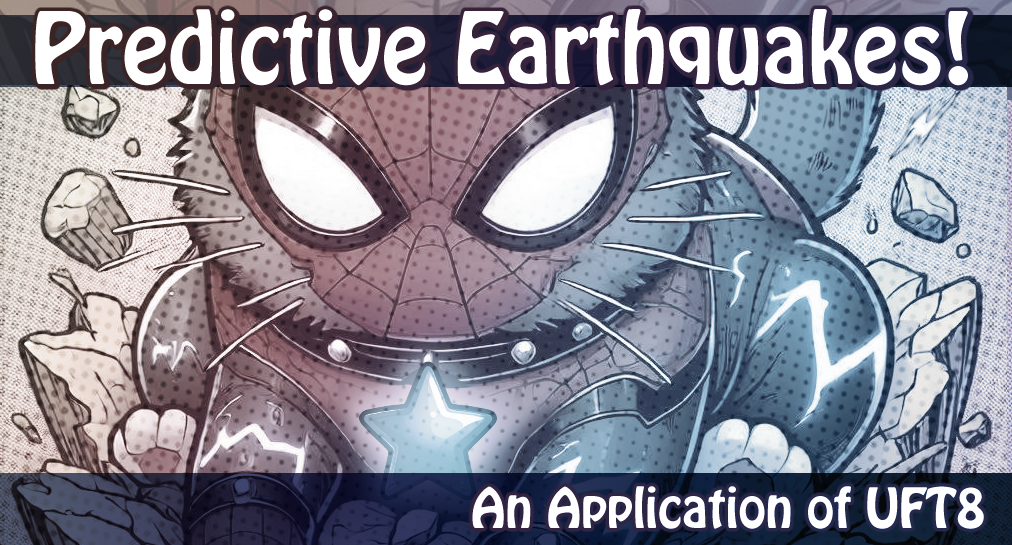| Earthquake Prediction Results! |
LINK |

|
|
Earthquakes have long been considered unpredictable, their timing and intensity dictated by forces beyond our control. Yet, patterns emerge. Tectonic stress accumulates, fault lines shift, and the Earth’s internal mechanics reveal clues; if we learn how to listen. The results of Earth Vibe Check (EVC), formerly known as SpiderQuake, suggest that seismic forecasting may be entering a new era.
While no model is perfect, EVC has demonstrated notable successes, while also highlighting areas requiring further refinement. This study has expanded to not just about prediction; it is about accuracy, refinement, and what comes next.
By analyzing EVC’s performance, we identify what works, where improvements are needed, and how seismic forecasting may soon transition from probability-based models to actionable early warnings (...)
(read more)
|
|
| The Fictitious Nature of Singularities |
LINK |

|
The traditional understanding of singularities, particularly in the context of black holes, posits a point of infinite density at the center of a sphere. This concept has long dominated classical interpretations of gravitational collapse and spacetime distortion.
However, when viewed through the lens of the Toroidal Unified Energy Curvature Equation, the geometric and physical assumptions underpinning singularities are revealed as fundamentally fictitious.
The Toroidal Unified Energy Curvature Equation draws directly from the principles within Unified Field Theory 8.0 (UFT8), uniting diverse fields under a single, comprehensive framework. Its ability to dynamically integrate mass-energy coupling, rotational coherence, and geometric scaling offers understanding of the universe, and a foundation for the next generation of theoretical and applied physics. |
The toroidal framework challenges the validity of such static and reductive models, offering a dynamic and holistic alternative.
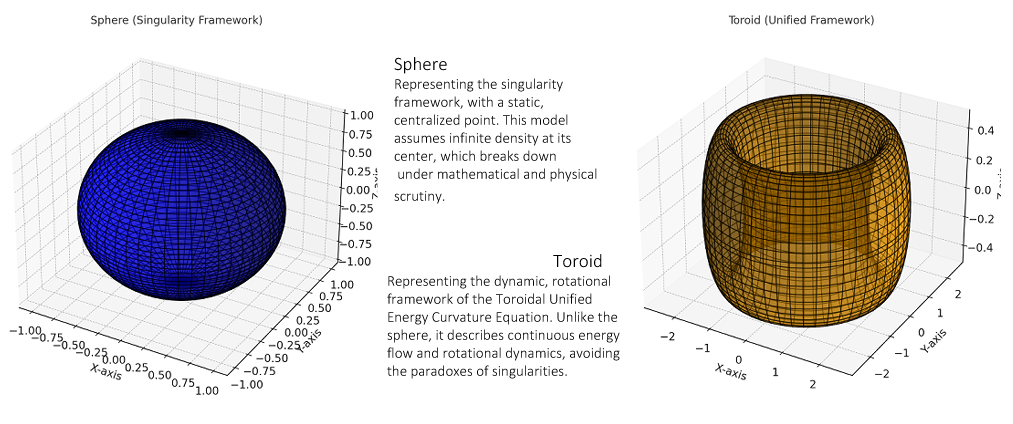
The geometry of a sphere, as traditionally envisioned at the core of a toroidal system, is inconsistent with the principles governing toroidal energy dynamics. Unlike a sphere, which implies a static, centralized locus of mass and energy, a toroid describes a dynamic and continuous flow of energy and curvature. |
In the toroidal model, there is no "center" in the conventional sense; instead, energy and spacetime are modulated through rotational flux and coherent phase interactions.
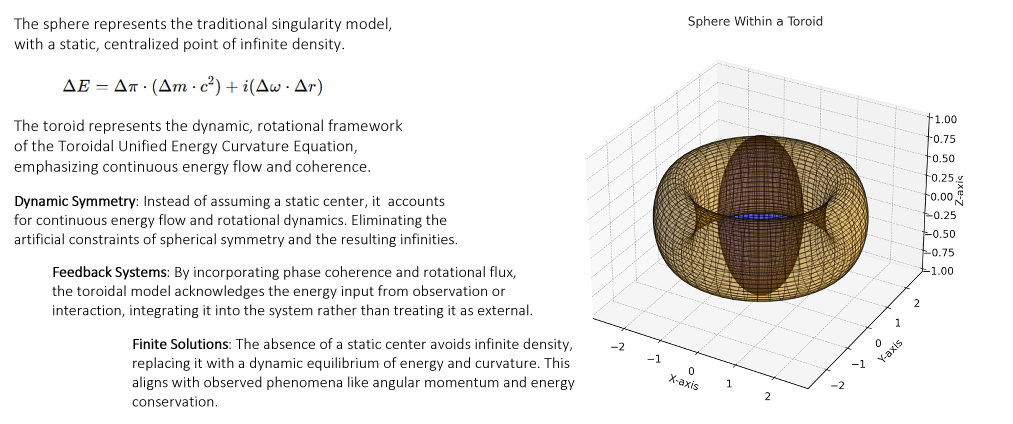
The assumption of a singular, infinitely dense point disrupts this natural flow, rendering it incompatible with the observed properties of toroidal systems.
|
| |
| Toroidal Unified Energy Curvature Equation |
\[
\Delta E = \Delta \pi \cdot (\Delta m \cdot c^{1/3}) + i(\Delta \omega \cdot \Delta r)
\]
|
The Unified Energy Curvature Equation directly incorporates rotational dynamics (Δω) and spatial modulation (Δr), rejecting the static simplicity of a sphere or singularity. The equation demonstrates that energy transformations are inherently phase-dependent and rotationally coupled.
Singularities, which imply a breakdown of spacetime into infinite curvature, fail to account for these coherent interactions.
Instead, the toroidal model suggests a finite, dynamic structure where energy density and curvature are regulated through feedback loops, avoiding the mathematical and physical inconsistencies of infinite density.
|
For Example
The Fibonacci spiral provides a visual representation of the Unified Energy Curvature Equation. Its dynamic flow, phase dependence, and feedback loops reflect the equation’s principles, with the toroidal model's description of spacetime and energy behavior in complex systems.
The discrete Fibonacci boxes emphasize that energy density and spatial relationships are not infinite or undefined, but grow in coherent, and quantifiable steps.
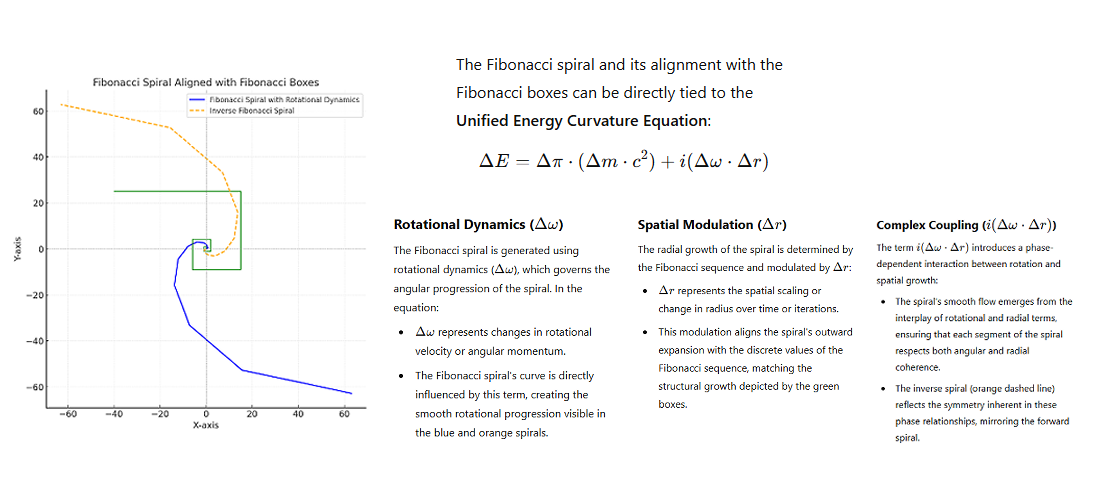
By incorporating rotational dynamics (Δω) and spatial modulation (Δr), it naturally rejects static and infinite constructs like singularities.
|
The fictitious nature of singularities underscores the limitations of purely spherical geometries in modeling complex systems.
The toroidal approach highlights the importance of dynamic interactions and rotational coherence in describing the behavior of spacetime and energy.
By replacing the static "center" with a continuously interacting flux, the toroidal model aligns more closely with observed phenomena, such as the angular momentum of accretion disks and the coherent structure of magnetic fields in astrophysical systems.
|
| |
| What we learned: |
The Toroidal Unified Energy Curvature framework demonstrates that singularities, defined as points of infinite density, are mathematical artifacts rather than physical realities. The appearance of infinities signals a breakdown in the equations, requiring reevaluation rather than acceptance as a solution.
The toroidal model replaces the concept of a central sphere with a dynamic structure where energy and spacetime interact through rotational flux and phase coherence. Eliminating the need for infinite density, preserving conservation laws and aligning with observable phenomena like angular momentum and energy flow.
Infinities in mathematical models always indicate that something has gone wrong. The toroidal approach resolves these errors by embedding dynamic, continuous processes into the geometry, ensuring that the equations describe coherent, finite physical systems.
|
|
Finally, the geometric assumption of a sphere at the core of a toroidal energy system, and the associated concept of singularities; fails to capture the dynamic and interconnected nature of energy and spacetime.
The Toroidal Unified Energy Curvature Equation is a robust framework for understanding these phenomena, emphasizing the importance of rotation, phase coherence, and energy modulation.
It dispels the fictitious notion of singularities but also opens new avenues for exploring the true nature of extreme gravitational systems.✮⋆˙
|
Scott R, January 21 2025
|
|
| Unified Field Theory 8 |
LINK |
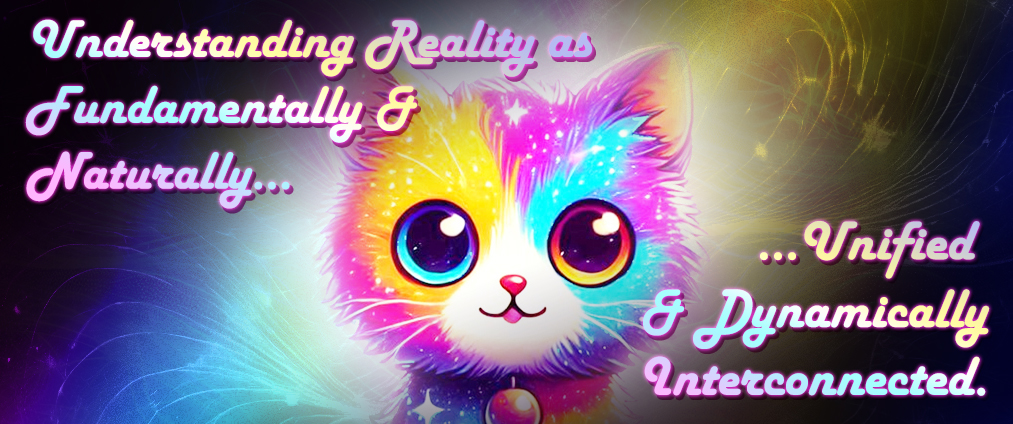
Unified Field Theory 8 reveals the universe as a seamless, interconnected network where quantum and cosmic scales are inherently unified. At its heart, scalar fields serve as the bridge, naturally linking the smallest quantum fluctuations to the vast gravitational dynamics of spacetime.
These fields enable a continuous dialogue between microscopic quantum systems and macroscopic gravitational phenomena, creating a dynamic, self-reinforcing process that defines the structure, behavior, and evolution of the cosmos as a singular, cohesive whole.
A universe that operates as a singular reaction where stability, direction, structure, and adaptability arise from the same continuous system. Governing the behavior of galaxies, the flow of energy in biological systems, the patterns of tectonic activity, and even the coherence of consciousness itself.(...)
(read more)
|
|






















